Pumpkin Patch & Paws: Can Cats Eat Pumpkin Safely? A Vet-Reviewed Guide
- 14 Apr 2025 11:06
As the seasons change or when dealing with feline digestive woes, pumpkin often comes up in conversations among cat owners. We know it's packed with nutrients for humans, and its smooth texture seems appealing. This leads many to ask the important question: can cats eat pumpkin? Is this common gourd a safe, beneficial supplement, or does it pose hidden risks for our obligate carnivore companions?
The good news is that yes, plain, cooked pumpkin can be safe and even beneficial for cats, particularly for digestive health, when given in moderation. However, the **type** of pumpkin and its **preparation** are absolutely critical. Not all forms of pumpkin are safe, and some can be downright dangerous. This comprehensive guide, adhering to E-E-A-T standards (Experience, Expertise, Authoritativeness, Trustworthiness) and reviewed for veterinary accuracy, will explore the benefits, risks, safe forms (like canned vs. raw vs. pie filling), appropriate dosages, and how to incorporate pumpkin for cats safely into their routine.

What's Inside a Pumpkin? Nutritional Lowdown
Pumpkin, a type of winter squash, is known for its dense nutritional profile (for humans):
Fiber:** High in both soluble and insoluble fiber, which plays a key role in digestive regulation.
Vitamins:** Rich in Vitamin A (as beta-carotene), Vitamin C, and Vitamin E. Also contains some B vitamins.
Minerals:** Provides potassium, copper, manganese, and smaller amounts of iron and magnesium.
Water Content:** Naturally high in moisture.
Low Calorie:** Relatively low in calories compared to its volume.
Antioxidants:** Contains antioxidants like beta-carotene.
While impressive for humans, we need to translate this into what's relevant and usable for a cat's unique biology.
Feline Physiology: Why Pumpkin Isn't a Staple Food
Cats are **obligate carnivores**. Their bodies evolved to extract nutrients primarily from animal prey. Key differences impacting how they handle pumpkin include:
Protein Needs:** Require high levels of animal-based protein. Pumpkin offers very little protein.
Carbohydrate Metabolism:** Minimal need for carbs; lack efficient enzymes to digest large amounts of starches or complex plant fibers found in pumpkin.
Vitamin A Conversion:** Cats cannot efficiently convert beta-carotene (abundant in pumpkin) into usable Vitamin A (retinol). They *must* obtain pre-formed Vitamin A from animal sources (like liver). Therefore, pumpkin is **not** a good source of Vitamin A *for cats*.
Essential Nutrients:** Pumpkin lacks critical nutrients like taurine and arachidonic acid, found only in animal tissues.
This means pumpkin should never replace a cat's balanced, meat-based diet. Its role is primarily supplemental, leveraging its fiber and moisture content for specific benefits.
The Benefits of Plain Cooked Pumpkin for Cats
When offered correctly (plain, cooked, in moderation), pumpkin can be beneficial, primarily for digestive health:
1. Digestive Regulator (Constipation & Diarrhea)
This is the most well-known benefit. The unique fiber blend in pumpkin works wonders for digestive regularity:
Soluble Fiber:** Absorbs excess water in the digestive tract, helping to firm up loose stools in cases of mild diarrhea. It also acts as a prebiotic, feeding beneficial gut bacteria.
Insoluble Fiber:** Adds bulk to the stool, helping to stimulate bowel movements and alleviate mild constipation.
Mechanism:** Helps normalize bowel function whether the issue is too loose or too firm (within limits).
Offering canned pumpkin for cat diarrhea or constipation is a common veterinary recommendation for mild cases, but always consult your vet first to rule out serious underlying causes.
2. Hairball Control
The fiber can help move ingested hair through the digestive tract more effectively, potentially reducing the frequency or severity of hairballs.
3. Hydration Boost (Minor)
Pumpkin has a high water content (especially canned puree), contributing slightly to a cat's overall fluid intake. This is particularly helpful for cats eating primarily dry kibble.
4. Weight Management Aid
Pumpkin is low in calories but high in fiber and water, promoting a feeling of fullness (satiety). Adding a small amount to a cat's food can help them feel satisfied while consuming fewer calories, potentially aiding in weight loss programs (under veterinary supervision).
5. Nutrient Contribution (Minor)
While not primary sources for cats, pumpkin does provide small amounts of potassium, Vitamin C (though cats make their own), and other micronutrients.
These benefits hinge entirely on using the **right type** and **right amount** of pumpkin.
CRITICAL WARNINGS: Unsafe Forms of Pumpkin for Cats
Not all pumpkin is created equal or safe. Avoid these forms entirely:
1. **Pumpkin Pie Filling** - **EXTREMELY DANGEROUS**
This is the single most important distinction. Canned pumpkin pie filling looks similar to plain puree but is **toxic** to cats.
High Sugar Content:** Loaded with sugar (often corn syrup), which is unhealthy, causes digestive upset, and risks long-term issues like obesity and diabetes.
Toxic Spices:** Contains spices like **nutmeg**, which is toxic to cats even in small amounts, potentially causing hallucinations, disorientation, increased heart rate, abdominal pain, and seizures. Other spices like **cloves** and potentially **cinnamon** (in large amounts) can also be problematic or irritating.
Other Additives:** May contain dairy, fats, or other unsuitable ingredients.
**NEVER feed pumpkin pie filling or pumpkin pie itself to your cat.** Always check the label to ensure you are buying **100% pure pumpkin puree**, NOT pie filling.
2. Raw Pumpkin - Not Recommended
While not toxic like the plant's leaves/stems, feeding raw pumpkin to cats is ill-advised:
Indigestible:** Raw pumpkin flesh and pulp are hard for cats to digest, likely causing significant gastrointestinal upset (gas, bloating, diarrhea, vomiting).
Choking Hazard:** Hard pieces of raw pumpkin can be a choking risk.
Cooking breaks down the tough cell walls, making the pumpkin digestible and safer.
3. Pumpkin Skin, Stem, and Leaves
Indigestible:** The skin and stem are tough and fibrous, offering no nutritional value and potentially causing digestive upset or obstruction if large pieces are swallowed.
Potential Irritants:** The leaves and stem might contain compounds that could irritate a cat's mouth or stomach. The prickly parts of the stem/leaves can cause physical irritation.
Choking Hazard:** Hard stem pieces are a risk.
Only feed the cooked flesh/pulp.
4. Jack-O'-Lanterns / Decorative Pumpkins
Mold/Bacteria:** Carved pumpkins left sitting out quickly develop mold and bacteria, which are harmful if ingested.
Potential Contaminants:** Decorative pumpkins might have been treated with preservatives or paints.
Candle Wax:** Residue from candles used inside can be harmful.
Do not let your cat nibble on used decorative pumpkins.
5. Seasoned or Prepared Pumpkin Dishes
Pumpkin cooked for human meals (soups, roasted pumpkin with spices/oil/salt) is unsuitable due to added ingredients like salt, fats, sugars, and potentially toxic seasonings (onion, garlic).
Pumpkin Seeds for Cats: Safe or Risky?
What about the seeds? This is another area needing caution:
Raw Pumpkin Seeds:** Whole raw seeds are a choking hazard and can be difficult to digest. While they contain nutrients like zinc, magnesium, and some fatty acids, these are better obtained from a balanced diet.
Roasted Pumpkin Seeds:** Often prepared with salt, oil, and spices, making them unsafe. Plain roasted seeds are still high in fat and calories and pose a choking risk if whole.
Ground Pumpkin Seeds:** Some sources suggest *finely ground*, raw, unsalted pumpkin seeds *might* offer some benefits (potential anti-parasitic properties are sometimes claimed, though evidence in cats is weak). However, proper grinding is essential to avoid choking and aid digestion. **This should only be considered under veterinary guidance**, as adding concentrated fats and fiber needs careful consideration within the overall diet. For most cats, the risks and hassle outweigh potential benefits.
Generally, it's safest to avoid feeding pumpkin seeds to cats, especially whole or roasted ones.
The Best Choice: 100% Pure Canned Pumpkin Puree
For convenience and safety, **100% pure canned pumpkin puree** (NOT pie filling) is the most recommended form for cats:
Consistent Texture:** Smooth puree is easy to mix with food and poses no choking risk.
Cooked & Digestible:** Already cooked, making the nutrients and fiber accessible.
Convenient:** Easy to store (refrigerate after opening) and measure.
Safe (When Pure):** Ensure the *only* ingredient listed is pumpkin.
You can also cook fresh pumpkin yourself, but ensure it's plain and pureed.
How to Safely Prepare & Serve Pumpkin to Cats
If using fresh pumpkin or offering canned puree:
Using Fresh Pumpkin:
Choose Edible Variety:** Select a pie pumpkin or similar edible squash.
Wash Exterior:** Clean the outside.
Remove Seeds, Stem, and Stringy Pulp:** Scoop these out.
Cut Flesh:** Cut the pumpkin flesh into manageable chunks (discard skin).
Cook Thoroughly:** Steam, boil, or bake the pumpkin chunks until very soft. **NO additives** (salt, oil, sugar, spices).
Mash or Puree:** Mash the cooked pumpkin until smooth. Remove any remaining lumps.
Cool Completely:** Allow the puree to cool before serving.
Serving Canned or Homemade Puree:
Check Ingredients (Canned):** Double-check it's **100% pure pumpkin**, NOT pie filling.
Measure Dose:** Use the appropriate amount (see below).
Mix with Food:** The easiest way is usually to mix the small amount of pumpkin thoroughly into your cat's regular wet or dry food.
Serve Plain:** You can also offer it plain, but mixing often improves acceptance.
Refrigerate Leftovers:** Store unused canned or homemade puree in an airtight container in the refrigerator for up to 5-7 days, or freeze in small portions (like an ice cube tray) for longer storage.
Dosage: How Much Pumpkin Can Cats Eat?
This is crucial – too much pumpkin will likely cause diarrhea or other issues. **Always start small** and consult your vet, especially if using it therapeutically.
Starting Dose:** Begin with just **1/2 teaspoon** mixed into food once or twice a day.
Typical Therapeutic Range (Vet Guidance Recommended):** For mild diarrhea or constipation, vets often recommend **1 to 2 teaspoons** per meal (or up to 1 tablespoon total per day for larger cats), but this depends heavily on the cat's size, the severity of the issue, and individual tolerance. **Do not exceed this without veterinary advice.**
As a General Supplement/Treat:** If just adding for potential fiber or hydration, stick to the lower end – **1/2 to 1 teaspoon per day** is usually sufficient and less likely to cause issues.
Introduce Gradually:** Don't suddenly add a large amount. Start small and increase slowly over several days if needed, monitoring stool consistency.
Short-Term Use Preferred:** While generally safe long-term in small amounts if tolerated, using pumpkin to manage chronic digestive issues requires veterinary investigation to address the underlying cause.
**Always consult your veterinarian before using pumpkin to treat a medical condition.**
Expert Veterinary Opinion on Pumpkin for Cats
Veterinarians generally view plain, cooked pumpkin positively but with important caveats:
It's recognized as a safe and often effective source of fiber for managing mild, non-obstructive **constipation and diarrhea**.
**100% pure canned pumpkin puree** is the preferred and most convenient form.
They strongly warn **against pumpkin pie filling** due to toxic spices and sugar.
They advise **against raw pumpkin** and other plant parts due to indigestibility and potential hazards.
Emphasis is placed on **moderation and appropriate dosage** to avoid causing further GI upset.
Pumpkin is a **supplement**, not a replacement for a balanced diet, and its use for medical issues requires a **veterinary diagnosis** first.
While generally safe, any new food can cause issues in individual cats, so monitoring is important.
Summary Table: Cats and Pumpkin Safety
| Aspect | Safety Information & Recommendations |
| Can Cats Eat Pumpkin? | Yes, **PLAIN, COOKED** pumpkin (flesh/puree) is safe and potentially beneficial in moderation. |
| Benefits | Digestive aid (diarrhea/constipation), hairball control, hydration (minor), weight management aid (low cal/high fiber). |
| UNSAFE Forms | **Pumpkin Pie Filling (Toxic!)**, Raw Pumpkin, Skin, Stem, Leaves, Seeds (mostly), Jack-o-Lanterns, Seasoned Pumpkin. |
| Best Form | **100% Pure Canned Pumpkin Puree** (NOT pie filling) or plain, home-cooked, pureed pumpkin flesh. |
| Risks of Safe Forms | GI Upset (if too much given), potential nutrient imbalance (if replacing balanced food). |
| Pumpkin Seeds | Avoid whole/roasted (choking/salt/fat). Finely ground raw seeds *might* have niche use but require vet guidance. Generally avoid. |
| Preparation | Cook thoroughly (steam/boil/bake), puree/mash, serve PLAIN. Check canned label (100% pumpkin only). |
| Dosage | Start small (1/2 tsp). Typical max: 1-2 tsp per meal (up to 1 Tbsp/day). **Consult vet for therapeutic use/dosage.** |
| Recommendation | Safe & beneficial supplement (esp. for GI health) when plain, cooked & in moderation. Always avoid pie filling & raw parts. Consult vet for medical use. |
Navigating Cat Health Questions? PettureX Offers Support!
Understanding the nuances of feline nutrition, like knowing the safe ways to use pumpkin for cats and avoiding dangerous forms like pie filling, is key to responsible pet care. If your cat experiences digestive issues or if you have questions about using supplements like pumpkin, getting reliable guidance quickly can be very helpful while you consult your primary veterinarian.
The PettureX App provides innovative tools for informed pet parents:
24/7 AI Vet Consultation: Get immediate AI-powered answers to questions about diet ("How much canned pumpkin for cat diarrhea?"), supplement safety, or symptoms like vomiting or constipation, helping you assess the situation anytime.
Image Recognition Technology: Useful for breed identification or getting preliminary insights into visible health concerns.
AI-Powered Symptom Checker: Describe your cat's symptoms (e.g., straining in litter box, loose stools) for an AI analysis of potential causes, aiding communication with your vet.
Comprehensive Pet Health Database: Quickly access information on feline nutrition, common health issues, safe foods, and preventive care.
PettureX serves as a valuable digital assistant, offering convenient AI-driven support and information, designed to complement the essential, personalized diagnosis and treatment plan provided by your veterinarian.
Conclusion: Plain Pumpkin Can Be a Purr-fectly Safe Supplement (in Moderation)
In conclusion, the answer to "can cats eat pumpkin?" is a conditional yes. Plain, cooked pumpkin puree (either 100% pure canned or properly prepared at home) is safe for cats in moderation and can be particularly beneficial for regulating mild digestive issues like constipation or diarrhea due to its unique fiber content. It can also aid in hairball control and weight management programs.
However, it is absolutely crucial to **avoid pumpkin pie filling**, which is toxic due to sugars and spices. Raw pumpkin, stems, leaves, skin, and usually seeds should also be avoided due to indigestibility and potential hazards. Always introduce pumpkin slowly, use appropriate dosages (typically 1/2 tsp to 1 Tbsp daily, vet guidance recommended), and ensure it complements, rather than replaces, their complete and balanced, meat-based diet.
When used correctly, pumpkin can be a safe and helpful addition to your cat's routine, but always prioritize their obligate carnivore needs and consult your veterinarian for guidance on using it for therapeutic purposes.
Related
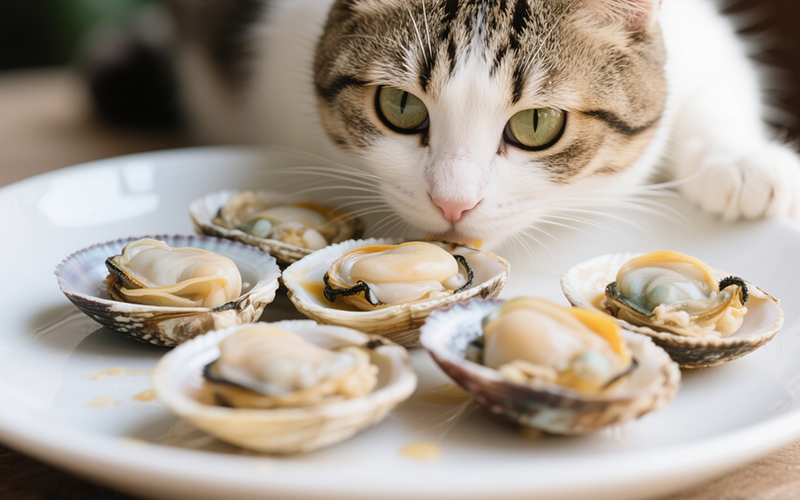
Seafood Surprise: Can Cats Eat Clams Safely? (Vet-Reviewed Risks & Guide)
- 15 Apr 2025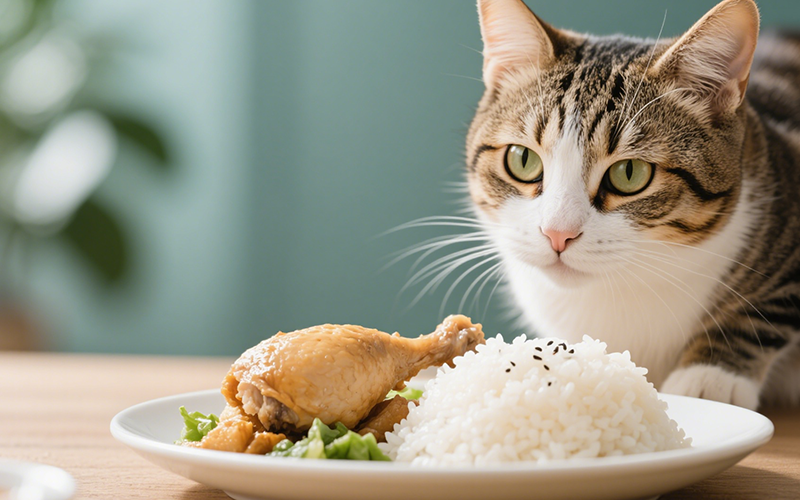
Chicken & Rice for Cats: Safe Treat or Dietary Danger? (Vet-Reviewed Guide)
- 15 Apr 2025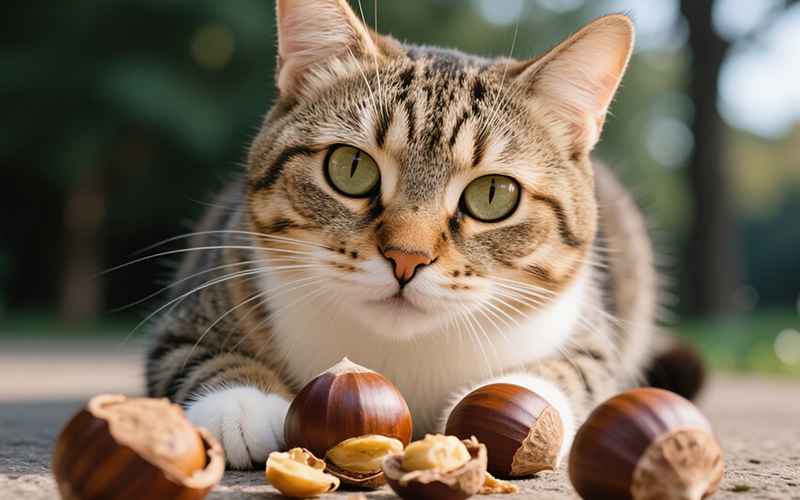
Nutty Concerns: Can Cats Eat Chestnuts Safely? Vet Explains the Risks (True vs. Horse Chestnuts)
- 15 Apr 2025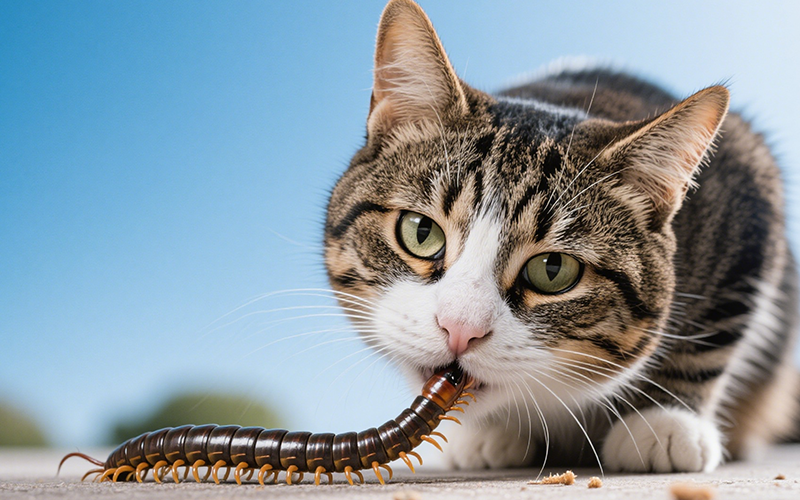
Creepy Crawly Cuisine? Can Cats Eat Centipedes Safely? (Vet-Reviewed Warning)
- 15 Apr 2025
The Gourd Guide: Can Cats Eat Canned Pumpkin Safely? Vet-Reviewed Benefits & Risks
- 15 Apr 2025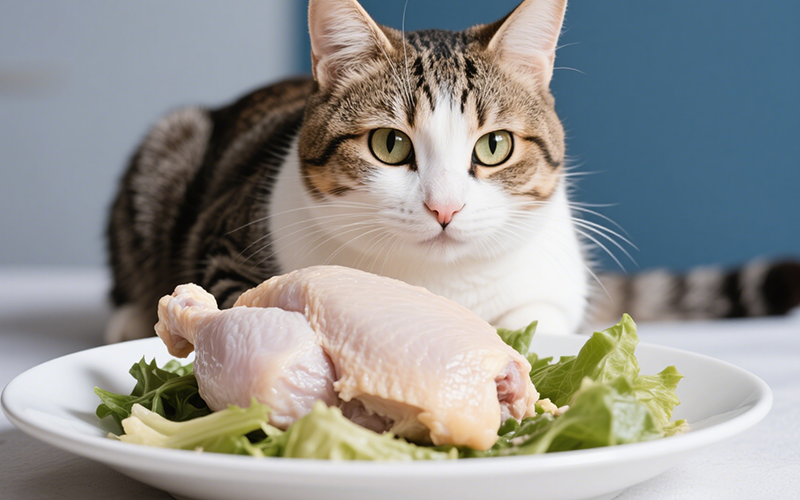
Boiled Chicken for Cats: A Purrfectly Safe Treat or Potential Pitfall? (Vet-Reviewed Guide)
- 15 Apr 2025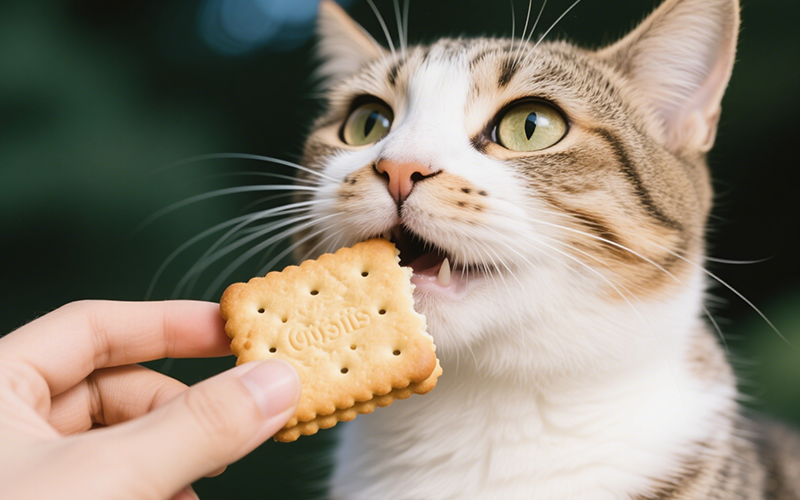
The Crumbly Truth: Can Cats Eat Biscuits Safely? Vet Warns of Hidden Dangers
- 15 Apr 2025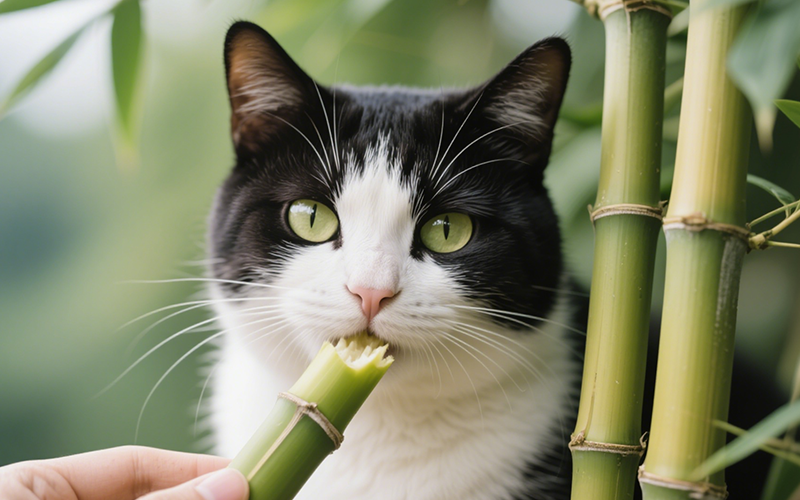
Green Stalks & Curious Cats: Can Cats Eat Bamboo Safely? (Vet-Reviewed Guide)
- 15 Apr 2025
Beef Liver for Cats: Nutrient Powerhouse or Risky Treat? (Vet-Reviewed Safety Guide)
- 15 Apr 2025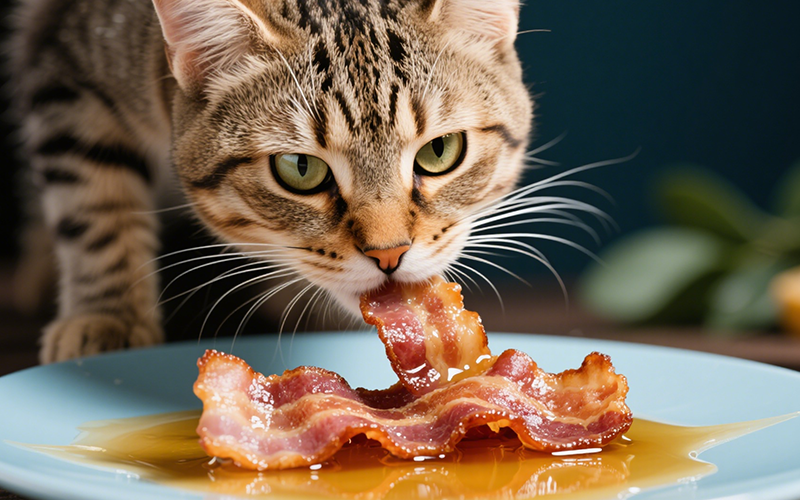
Fat Trap Alert: Can Cats Eat Bacon Grease Safely? (Vet-Reviewed Dangers)
- 15 Apr 2025
